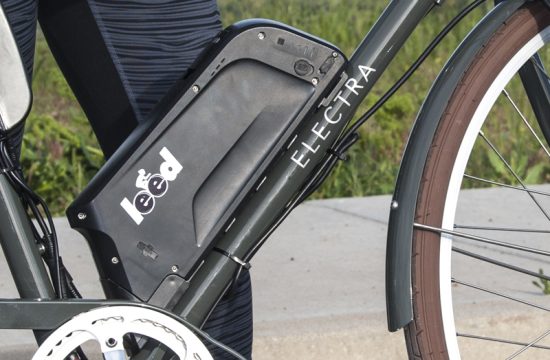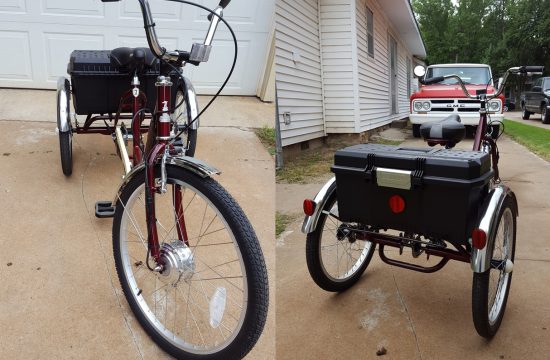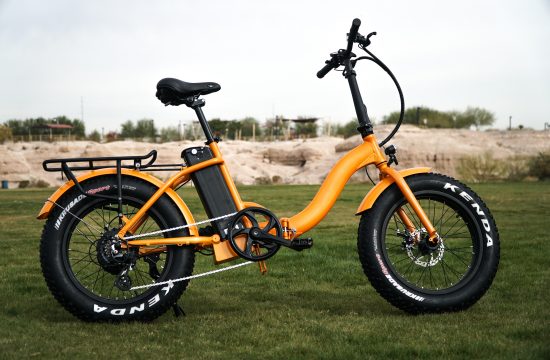For hard-core mountain bikers who use traditional bicycles on the trails, it may not be the most appetizing idea to swallow, but electric bikes can (generally) be ridden on mountain biking trails. Some may think that electric bikes are a crutch and are ruining the experience for traditional mountain bikers, but we at Leeds Bicycle believe that everyone should be able to experience the adrenaline rush of riding down a rock-ridden trail and maneuvering around and through trees, corners, and up hills. But it’s the hills that prevent many people from enjoying mountain biking.
With an electric bike, however, a battery-powered motor provides some assistance, helping people make it up steep or difficult hills when they would otherwise have to get off the bike to walk up. Seems like a win-win right? But even with an e-bike, mountain biking can be fairly intimidating, especially when many people automatically imagine professional mountain bikers making huge jumps and riding down incredibly challenging hills. So if you recently purchased an electric bike or e-bike conversion kit and want to give mountain biking a try, but are a little wary, here are a few tips to help make your first ride easier and more enjoyable.
Build a Fitness Foundation
It’s undeniable that mountain biking, even with an electric bike, is challenging. Riding uphill, over rocks or fallen trees, managing the steering — it’s all a great workout, but it may take some initial training at first. Before you hit the trails where you have to deal with other riders, first find a relatively steep hill near you. It can be a paved road, but a grassy hill would be ideal so you can begin to feel some resistance. As you become more and more comfortable going up hills, you can start looking for easy mountain bike trails.
Safety, Safety, Safety
When it comes to mountain biking, safety is paramount. When you’re riding a bike, regardless of whether it’s a traditional or an e-bike or whether you’re on the road or a mountain trail, you should always wear a helmet. In addition, make sure that the helmet is fitted properly to your head. If you’re hitting the trails, you may also want to consider wearing knee and elbow pads.
Another factor of safety is knowing your bike and how to use it effectively. Be sure you understand how the gears work, familiarize yourself with how your brakes feel and how they work (braking power is in the front wheel), get a feel for how much assistance your electric bike provides, and make any necessary adjustments to the bike’s seat so that the height is comfortable. And because it’s worth mentioning again — always wear a helmet.
Pick the Right Trail
When you first start out, you’ll want to find a trail that is rated as easy, or read reviews to see what others are saying about the trail’s difficulty. You’re essentially trying to find a trail that matches your fitness level. The first time you mountain bike, it may be surprising just how much effort it takes, so try a trail that is shorter. A first-time trail should take between 30 and 45 minutes. If you are riding an electric bike, make sure that the battery will last the whole ride, or be sure to have an additional battery with you. If you find that you’re struggling with a hill, don’t worry about having to get off the bike and hike it up. People do this all the time, so no one is judging you.
Body Position
As you get more experienced with mountain biking and give more difficult trails a try, you’ll see that there are a variety of obstacles and terrain to get over, including rocks, trees, roots, sand, and mud. In order to get across these obstacles and terrain, it’s important to understand how to best position your body. There are two main body positions: neutral and ready.
Neutral Position: This is most likely the position you will be in for the majority of the trail. You’re in a neutral position when there aren’t any technical obstacles to get over. Slightly bend your elbows and knees; keep your pedals even and the weight distributed evenly; keep your index fingers on the brake levers; look ahead between 15 and 20 feet.
Ready Position: When the trail gets more technical, either rockier or steeper, this position protects your body and gets you prepared for any obstacles that come your way. Keep your pedals evenly weighted; keep your knees and bellows at around a 90-degree angle; pick your butt up off of the seat and shift your hips back; flatten your back so that it’s nearly parallel to the ground.
Mountain Biking With an Electric Bike
These are just a few tips to help prepare you for mountain biking for the first time. Whatever your fitness level, it’s important to start with easier trails and work your way up to more difficult terrain. This will give you time to become familiar with how a bike moves when traveling over terrain that isn’t simply pavement.
If steep hills are keeping you from giving mountain biking a try, an electric bike may be a great solution. And if you already have a traditional bike and don’t want to spend thousands on a new e-bike, Leeds Bicycle makes it easy to equip your current bike with a battery-powered motor.
Leeds offers high-quality electric bikes and conversion kits to make it easy for everyone to get in a great ride. Shop our off-road electric bikes today!
The post Tips For First-Time Mountain Biking appeared first on Leeds Bikes.










